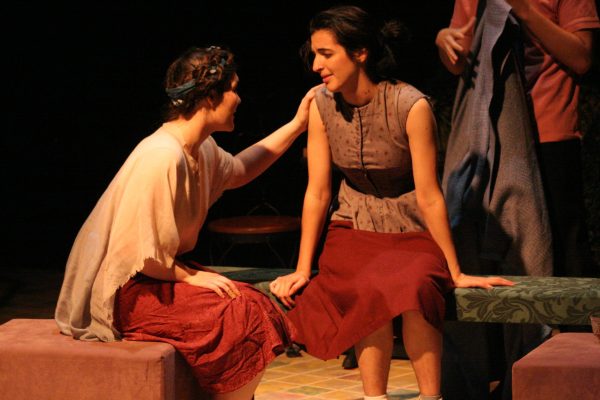Mainstage Production Ophelia: A Prism Expands on Femininity, Grief, Love in Hamlet
Editors’ note: This article contains mention of suicide, racism, and misogyny.
I’ve seen many different versions of Hamlet performed — from Hamlet set in a nuclear bunker to a Hamlet that debuted inside a food court. I’ve always loved the story, watching Hamlet’s facade of madness and need for revenge. Ophelia: A Prism, performed in the Irene and Alan Wurtzel Theater, showcased a performance that not only spellbound me but easily became one of my favorite adaptations — and Hamlet isn’t even the main character. Instead, the focus is on Hamlet’s lover, Ophelia, or in this case, multiple Ophelias, as the character in this version of the play is split into three different essences. Ophelia eventually descends into madness from three different angles, which truly encapsulates the pressures of being a Black woman in a world that caters to men and those with fair skin.
I enjoyed the concept of splitting Ophelia into three versions of herself. I felt the rawness of the characters acting out Ophelia’s inner thoughts and feelings. Each Ophelia represents different emotion or aspiration. Green Ophelia (College third-year Tseli Mathebula), the diplomat, acts as the balanced voice of reason who interacts most often with the other characters around them. They also represent the femininity and grace that a woman during this time period was expected to present. But behind this facade is Brass Ophelia (College fourth-year Karah Innis), the warrior who wants to fight dragons instead of playing the princess. Brass Ophelia represents the frustration that comes when dealing with the pressures of being the perfect woman; unable to rise above your status or speak for yourself. Finally, Orange Ophelia (College fourth-year Bianca Berger) embodies the raw anxiety that Ophelia feels, constantly worrying that she is not pretty, fair, wise, or good enough for Hamlet. The three stick together for the majority of the play, switching who speaks to other characters fluidly and acting as one body. No one Ophelia could exist without the others. When Brass Ophelia curses out her other selves, she curses herself as well. It creates a powerful image of what it’s like to constantly battle yourself on who you want to be, and more importantly, who you can be.
Throughout the show, Ophelia is presented with many challenges, which makes the inner monologues even more powerful. I empathize with Ophelia’s struggles not only to be a woman in her world but to be a Black woman facing prejudice from the characters around her. The Ophelias are reminded throughout the play that they are Black women living in a world where royalty is fair-skinned, like Hamlet (College third-year Leander Chow) and his mother Queen Gertrude (College second year Lia Fawley). The darkness of Ophelia’s skin is repeatedly commented on, and there are scenes where powder is applied to make them seem paler. The play makes it very clear that Ophelia not only has to fight as a woman, but also as a woman who doesn’t fit the beauty standard of the time. As a Black woman, I can say it was done well. It is consistent enough that you are frustrated with Ophelia’s environment and the unfairness of her situation. Ophelia’s journey resembles some of the everyday struggles that Black women are still going through.
I also really enjoyed the way Ophelia acts around different characters. Throughout each scene, you not only get a sense of the person Ophelia is trying to be but the feelings of her counterparts. While Green Ophelia speaks with Hamlet the majority of the time, acting gracefully and keeping up a mature front to seem more appealing to him, you also see Orange and Brass Ophelias’ responses and reactions. This becomes even more apparent as Hamlet descends into his madness. As Green Ophelia becomes unable to keep up their polished appearance, Brass and Orange start to speak up more, with Brass Ophelia voicing her frustrations to the characters around her more often and Orange Ophelia growing more fearful of Hamlet and his visions. The ghost of the previous King Hamlet, murdered by his brother and seeking revenge, strikes fear in Orange Ophelia and starts her down her own path of madness, eventually dragging the others along with her to their eventual end. The story thoroughly describes and portrays Ophelia in all her complexities, distinguishing itself from the original play which uses her as an archetype of feminine essence instead of a person.
I think that’s what I like the most about Ophelia: A Prism. Here, Ophelia is a character in her own right and not merely supporting Hamlet. We see Ophelia’s three selves being a large presence on stage. We learn so much about her as a person and who she wants to be, but the characters around Ophelia only see her as a woman whose value comes not from being an individual but from being a good wife and daughter. Ophelia is the loudest person on stage yet is not heard. When she succumbs to madness after trying for so long to be perfect for everyone around her, she is left alone. The silence of her death proves to be the most impactful moment of all. In the original play, audiences can see the characters left mourning her. Hamlet reminisces on his love for her, and Laertes (Cyril Amanfo OC’22) mourns the loss of his beloved sister. Queen Gertrude laments that she wishes to strew flowers around Ophelia and Hamlet’s marriage bed rather than on Ophelia’s fresh grave. After Ophelia commits suicide, she’s no longer the woman who was supposed to be the perfect lover and daughter. She’s just Ophelia, and the characters around her can finally start trying to see what the audience has seen the entire time and what Ophelia: A Prism is trying to portray: Ophelia in her entirety and all her parts.







